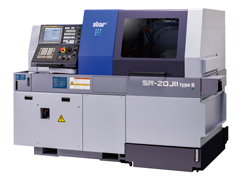Swiss Type Automatic Lathe SR-20JII to be Newly Released
Renewal of the Best-Selling Model SR-20J by Employing a Modular Design
Star Micronics has developed a new Swiss type automatic lathe (Note 1) model “SR-20JII” in the SR series, which is scheduled to be released in May, 2018.
The original model, “SR-20J” launched on the market in 2008, has been highly rated because of its high rigidity in all kinds of parts processing markets related to the automobile, medical and other industries. Like the model “SR-32JII” released last year, the renewed model employs a modular design and production system in order to reduce the lead time required for development and manufacture.
The gang-type tool post for front working is equipped with the Star original slanted slide guideway structure (Note 2) from the previous model. Enhanced rigidity of the tool post achieves accurate continuous machining for a long time.
In order to respond to diversification of needs for parts processing, the guide bush switching mechanism is introduced. With only a single machine, the guide bush type, which functions as a steady rest to enable accurate machining of long parts such as motor shafts, and the non-guide bush type (Note 3) which achieves machining of short parts such as nuts, etc. by reducing the residual materials to discard, can be switched over.
The non-guide bush type, in particular, is designed to improve the rigidity of the entire machine by employing a spindle sleeve slide guideway structure (Note 4) in order to ensure the headstock rigidity by supporting the cutting load generated during machining with the slide guideway.

Furthermore, the flip-up mechanism is used for the door of the cutting chamber and the headstock chamber each to ensure a sufficient work space inside the machine. A swing-type panel facilitates machine operation at an optimum position. The NC unit is equipped with various help functions including an alarm help function for checking alarm contents on NC screens to improve operator’s operability and workability in terms of both the software and machine sides.
Features of SR-20JII
[High Rigidity / High Accuracy]
- The gang-type tool posts adopt a slanted slide guideway structure with high rigidity.
- The non-guide bush type incorporates a spindle sleeve slide guideway structure. The slide guideway supports cutting force to ensure the headstock rigidity.
- Type B tool post designed for backworking employs a slanted dovetail structure on the Y2-axis slideway to achieve rigidity of the tool post.
- Both the main and sub spindles each use a built-in motor. A built-in sensor is also used to improve indexing accuracy.
[High Functionality]
- Either the guide bush type or non-guide bush type can be selected according to the total length of parts to be machined.
- The output of the sub spindle motor and power tool motor for the front/back-working tool post is improved. (when compared to STAR SR-20J)
- Type A tool post designed for backworking is equipped with a 4-spindle unit. By combining with optional units, a power tool unit can be mounted at all positions.
- Type B tool post designed for backworking has an 8-spindle unit with Y2-axis control function. A power tool unit can be mounted at all positions as standard.
NOTE 1: Swiss-type automatic lathe
The Swiss-type automatic lathe was devised as watch component processing machinery in Switzerland in 1870s. Known as a “sliding head-type automatic lathe” as well, it has remarkable characteristics of high-precision cutting of components with longer length compared with the diameter.
In general, if long and narrow parts are processed with a general-purpose lathe, flexure will occur on the workpiece, making finishing with the correct dimensions impossible. The Swiss-type automatic lathe utilizes a guide bush to function as a material steady rest. The tool, positioned at a certain distance from the guide bush, gives a cutting motion only the direction of outside diameter. This allows the workpiece to be cut accurately with no flexure. As for axial motion, the headstock, rather than the tailstock, moves while clamping a workpiece.
NOTE 2: Slanted slide guideway structure
The machine main body base and the tool post are slanted and each sliding surface is in a trapezoidal shape, called a dovetail structure. This structure allows each sliding surface to come into contact with its entire plane to improve the machine rigidity. The ball screw center and the cutting point are close to each other to reduce a load (moment load) applied in the direction of torsion caused by cutting resistance.
NOTE 3: Non-guide bush type
This is a sliding head-type automatic lathe which is designed based on the Swiss-type automatic lathe with a guide bush dismounted. Without a guide bush, it is not well suited for machining narrow and long parts. If the workpiece is short and does not deflect, however, such material can be handled effectively.
With the Swiss-type automatic lathe, the rear side of a bar material needs to be handled as waste as a portion equivalent to the size of the guide bush structure which functions as a steady rest for the material cannot be machined.
The non-guide bush type reduces the waste to about 1/3 in length compared to the waste made by the guide bush type.
NOTE 4: Spindle sleeve slide guideway structure
This structure has a sliding surface machined according to the outer diameter of the head stock spindle sleeve, which moves while clamping the workpiece. By eliminating the gap between the spindle sleeve and the guideway, the structure supports the cutting load applied to the head stock through the slide guideway and improves the head stock rigidity.
